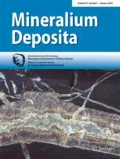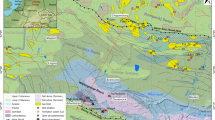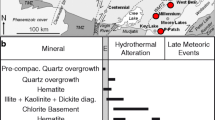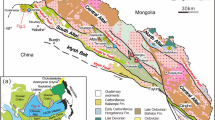Abstract
We report methane-dominant hydrocarbon (fluid) inclusions (CH4±C2H6–C2H2, C3H8) coexisting with primary brine inclusions and secondary halide melt (solid NaCl) inclusions in Au–Pt-rich quartz-sulfide-epidote alteration veins associated with the footwall-style Cu–PGE (platinum-group element)–Au deposits at the Fraser Mine (North Range of the Sudbury Igneous Complex). Evidence for coentrapment of immiscible hydrocarbon–brine, and hydrocarbon–halide melt mixtures is demonstrated. A primary CH4–brine assemblage was trapped during quartz growth at relatively low T (min. T trapping∼145–315°C) and P (max. P trapping∼500 bar), prior to the crystallization of sulfide minerals in the veins. Secondary inclusions contain solid halite and a mixture of CH4, C2H6–C2H2 and C3H8 and were trapped at a minimum T of ∼710°C. The halite inclusions may represent halide melt that exsolved from crystallizing sulfide ores that texturally postdate (by replacement) early alteration quartz hosting the primary, lower T brine–CH4 assemblage. Laser ablation ICP-MS analyses show that the brine, hydrocarbon and halide melt inclusions contain significant concentrations of Cu (0.1–1 wt% range), Au, Bi, Ag and Pt (all 0.1–10 ppm range). Cu:Pt and Cu:Au ratios in the inclusions are significantly (up to 4 log units) lower than in the host alteration veins and adjacent massive sulfide ore veins, suggesting either (1) early Cu loss from the volatiles by chalcopyrite precipitation or (2) enhanced Au and Pt solubilities relative to Cu at the temperatures of entrapment. Concentration ratios between coexisting brine and CH4 inclusions \([C^{{\rm elem}}_{{\rm brine}}/C^{{\rm elem}}_{{\rm CH_{4}}}]\) are lower for Cu, Au, Bi and Ag than for other elements (Na, Ca, Fe, Mn, Zn, Pb) indicating that during interaction with the brine, the hydrocarbon phase was enriched in ore metals. The high concentrations of ore metals in hydrocarbon, brine and halide melt phases confirm that both aqueous and non-aqueous volatiles were carriers of precious metals in the Sudbury environment over a wide range of temperatures. Volatile evolution and magmatic sulfide differentiation were clearly part of a single, continuous process in the Sudbury footwall. The exsolution of H2O-poor volatiles from fractionated sulfide liquid may have been a principal mechanism controlling the final distribution of PGE and Au in the footwall ore systems. The study reports the first measurements of precious metal concentrations in fluid inclusions from a magmatic Ni–Cu–PGE environment (the Sudbury district).















Similar content being viewed by others
References
Atkinson B (2002) A model for the PTZ properties of H2O–NaCl. PhD Thesis, Virginia Polytechnic Institute, pp 133
Ballhaus CG, Stumpfl EF (1986) Sulphide and platinum mineralization in the Merensky Reef: evidence from hydrous silicates and fluid inclusions. Contrib Mineral Petrol 94:193–204
Bodnar RJ (1994) Synthetic fluid inclusions; XII, the system H2O–NaCl; experimental determination of the halite liquidus and isochores for a 40 wt% NaCl solution. Geochim Cosmochim Acta 53:725–733
Bowers TS, Helgeson HC (1983) Calculation of the thermodynamic and geochemical consequences of nonideal mixing in the system H2O–CO2–NaCl on phase relations in geological systems; equation of state for H2O–CO2–NaCl fluids at high pressures and temperatures. Geochim Cosmochim Acta 47:1247–1275
Bray CJ, Spooner ETC (1992) Fluid inclusion volatile analysis by gas chromatography with photoionization/micro-thermal conductivity detectors; applications to magmatic MoS2 and other H2O–CO2 and H2O–CH4 fluids. Geochim Cosmochim Acta 56:261–272
Coats CJA, Snajdr P (1984) Ore deposits of the North Range, Onaping-Levack Area. In: Pye EG, Naldrett AJ, Giblin PE (eds) The geology and ore deposits of the Sudbury structure. Ontario Geological Survey special volume 1:327–346
Cowan JC (1968) Geology of the Strathcona ore deposit. Can Inst Mining Metallurg Bull 61:38–45
Dietz RS (1964) Sudbury structure an Astrobleme. J Geol 72:412–434
Dressler BO (1984) The effects of the Sudbury event and the intrusion of the Sudbury Igneous Complex on the Footwall Rocks of the Sudbury structure. In: Pye EG, Naldrett AJ, Giblin PE (eds) The geology and ore deposits of the Sudbury structure. Ontario Geological Survey spec vol 1:97–136
Ebel DS, Naldrett AJ (1997) Crystallization of sulfide liquids and the interpretation of ore composition. Can J Earth Sci 34:352–365
Erwood RJ, Kesler SE, Cloke PL (1979) Compositionally-distinct, saline hydrothermal solutions, Naica Mine, Chihuahua, Mexico. Econ Geol 74:95–108
Farrow CEG (1994) Geology, alteration, and the role of fluids in Cu–Ni–PGE mineralization of the footwall rocks to the Sudbury Igneous Complex, Levack and Morgan Townships, Sudbury District, Ontario. PhD Thesis, Carleton University
Farrow CEG, Lightfoot PC (2002) Sudbury PGE revisited: towards and integrated model. In: Cabri LJ (ed) The geology, geochemistry, mineralogy and mineral beneficiation of platinum-group elements. Canadian Institute of Mining, Metallurgy and Petroleum, Montreal, pp 273–297
Farrow CEG, Watkinson DH (1992) Alteration and the role of fluids in Ni, Cu and platinum-group element deposition, Sudbury igneous complex contact, Onaping—Levack Area, Ontario. Mineral Petrol 46:67–83
Frape SK, Fritz P (1982) The chemistry and isotopic composition of saline groundwaters from the Sudbury basin, Ontario. Can J Earth Sci 19:645–661
Frost BR, Touret JLR (1989) Magmatic CO2 and saline melts from the Sybille Monzosyenite, Laramie anorthosite complex, Wyoming. Contrib Mineral Petrol 103:178–186
Gammons CH, Williams-Jones AE (1997) Chemical mobility of gold in the porphyry-epithermal environment. Econ Geol 92:45–59
Goldstein RH (2003) Petrographic analysis of fluid inclusions. In: Samson I, Marshall D, Anderson A (eds) Fluid inclusions: analysis and interpretation. Mineralogical Association of Canada, Short Course Series Vol 32:9–54
Greenman L (1970) The petrology of the footwall breccias in the vicinity of the Strathcona Mine, Levack, Ontario. PhD Thesis, University of Toronto
Grieve RAF (1994) An impact model of the Sudbury structure: proceedings of the Sudbury. In: Lightfoot PC, Naldrett AJ (eds) Proceedings of the Sudbury–Noril’sk symposium. Ontario Geol Surv Spec Vol 5:119–132
Gunther D, Frischknect R, Heinrich CA (1997) Capabilities of a 193 nm ArF excimer laser for LA-ICP-MS microanalysis of geological materials. J Anal At Spectrom 12:939–944
Hanley JJ (2002) The distribution of the halogens in Sudbury Breccia matrix as as pathfinder elements for footwall Cu-PGE mineralization at the Fraser Cu Zone, Barnet Main Copper Zone, and surrounding margin of the Sudbury Igneous Complex, Onaping-Levack Area, Ontario, Canada. MSc Thesis, University of Toronto
Hanley JJ, Mungall JE (2003) Chlorine enrichment and hydrous alteration of the Sudbury Breccia hosting footwall Cu–Ni–PGE mineralization at the Fraser mine, Sudbury, Ontario, Canada. Can Mineral 41:857–881
Hanley JJ, Mungall JE, Bray CJ, Gorton MP (2004) The origin of bulk and water-soluble Cl and Br enrichments in ore-hosting Sudbury Breccia in the Fraser Copper Zone, Strathcona Embayment, Sudbury, Ontario, Canada. Can Mineral 42:1777–1798
Heinrich CA, Ryan CG, Mernagh TP, Eadington PJ (1992) Segregation of ore metals between magmatic brine and vapor; a fluid inclusion study using PIXE microanalysis. Econ Geol 87:1566–1583
Heinrich CA, Gunther D, Audetat A, Ulrich T, Frischknecht R (1999) Metal fractionation between magmatic brine and vapor, determined by microanalysis of fluid inclusions. Geology 27:755–758
Heinrich CA, Pettke T, and Halter WE (2003) Quantitative multi-element analysis of minerals, fluid and melt inclusions by laser-ablation inductively-coupled-plasma mass-spectrometry. Geochim Cosmochim Acta 67:3473–3497
Hemley JJ, Cygnan GL, Fein JB, Robinson GR, D’Angelo WM (1992) Hydrothermal ore-forming processes in the light of studies in rock-buffered systems: I. Fe–Cu Zn–Pb sulphide solubility relationships. Econ Geol 87:1–22
Jago BC, Morrison GG, Little TL (1994) Metal zonation patterns and microtextural and micromineralogical evidence for alkali- and halogen-rich fluids in the genesis of the Victor Deep and McCreedy East Footwall Copper Ore bodies, Sudbury Igneous Complex. In: Lightfoot PC, Naldrett AJ (eds) Proceedings of the Sudbury–Noril’sk Symposium. Ontario Geol Surv Spec Vol 5:65–75
Krader T, Franck EU (1987) The ternary systems H2O–CH4–NaCl and H2O–CH4–CaCl2 to 800 K and 250 MPa. Ber Bunsenges Phys Chem 9:627–634
Krogh TE, Davis DW, Deutch A (1984) Precise U–Pb zircon and baddeleyite ages for the Sudbury Area. In: Pye EG, Naldrett AJ, Giblin PE (eds) The geology and ore deposits of the Sudbury structure. Ontario Geological Survey Special Volume 1:431–446
Li C (1993) A quantitative model for the formation of sulfide ores at Sudbury and a tudy on the distributions of platinum-group elements in the Strathcona copper-rich zones, Sudbury, Ontario. PhD Thesis, University of Toronto
Li C, Naldrett AJ (1994) A numerical model for the compositional variations of Sudbury sulfide ores and its application of exploration. Econ Geol 89:1599–1607
Longerich HP, Jackson SE, Gunther D (1996) Laser ablation inductively coupled plasma mass spectrometry transient signal data acquisition and analyte concentration calculation. J Anal Atom Spectrom 11:899–904
Marshall D, Watkinson D, Farrow CEG, Molnar F, Fouillac AM (1999) Multiple fluid generations in the Sudbury igneous complex: fluid inclusion, Ar, O, H, Rb and Sr evidence. Chem Geol 154:1–19
Mathez EA (1987) Carbonaceous matter in mantle xenoliths; composition and relevance to the isotopes. Geochim Cosmochim Acta 51:2339–2347
Mathez EA, Deitrich VJ, Holloway JR, Boudreau AE (1989) Carbon distribution in the Stillwater Complex and evolution of vapor during crystallization of Stillwater and Bushveld magmas. J Petrol 30:153–173
Mavrogenes JA, Berry AJ, Newville M, Sutton SR (2002) Copper speciation in vapor-phase fluid inclusions from the Mole Granite, Australia. Am Mineral 87:1360–1364
Molnar F, Watkinson DH, Jones PC (2001) Multiple hydrothermal processes in footwall units of the North Range, Sudbury igneous complex, Canada, and implications for the genesis of vein-type Cu–Ni–PGE deposits. Econ Geol 96:1645–1670
Morrison GG, Jago BC, White TL (1994) Footwall mineralization of the Sudbury Igneous Complex. In: Lightfoot PC, Naldrett AJ (eds) Proceedings of the Sudbury–Noril’sk symposium. Ontario Geol Surv Spec Vol 5:57–64
Mountain BW, Seward TM (1999) The hydrosulphide/sulphide complexes of copper (I); experimental determination of stoichiometry and stability at 22°C and reassessment of high temperature data. Geochim Cosmochim Acta 63:11–29
Mungall JE, Brenan JM (2003) Experimental evidence for the chalcophile behaviour of the halogens. Can Mineral 41:207–220
Mungall JM, Ames DE, Hanley JH (2004) Geochemical evidence from the Sudbury structure for crustal redistribution by large bolide impacts. Nature 429:546–548
Naden J, Shepherd T (1989) Role of methane and carbon dioxide in gold deposition. Nature 342:793–795
Naldrett AJ, Kullerud G (1967) A study of the Strathcona Mine and its bearing on the origin of the nickel–copper ores of the Sudbury District, Ontario. J Petrol 8:453–531
Naldrett AJ, Pessaran A (1992) Compositional variation in the Sudbury ores and prediction of the proximity of footwall copper-PGE orebodies. In: Milne V (ed) Ontario Geol Survey Misc. Paper 159:47–62
Pettke T, Heinrich CA, Ciocan AC, Gunther D (2004) Quadrupole mass spectrometry and optical emission spectroscopy: detection capabilities and representative sampling of short transient signals from laser-ablation. J Anal Atom Spectrom 9:1149–1155
Pettke T, Diamond LW, Kramers JD (2000) Mesothermal gold lodes in the north-western Alps; a review of genetic constraints from radiogenic isotopes. Eur J Mineral 12:213–230
Poling BE, Prausnitz JM, O’Connell JP (2001) The properties of gases and liquids. McGraw-Hill, New York, pp 752
Potter J, Konnerup-Madsen J (2003) A review of the occurrence and origin of abiogenic hydrocarbons in igneous rocks. In: Petford N, McCaffrey KJW (eds) Hydrocarbons in crystalline rocks. Geological Society of London, Spec Pub 214:151–173
Renders PJ, Seward TM (1989) The stability of hydrosulphido- and sulphido-complexes of Au (I) and Ag (I) at 25°C. Geochim Cosmochim Acta 53:245–253
Renno AD, Leander F, Witzke T, Herzig PM (2004) The coexistence of melts of hydrous copper chloride, sulfide and silicate compositions in a magnesiohastingsite cumulate, TUBAF seamount, Papua New Guinea. Can Mineral 42:1–16
Salvi S, Williams-Jones AE (1992) Reduced orthomagmatic C–O–H–N–NaCl fluids in the Strange Lake rare-metal granitic complex, Quebec/Labrador, Canada. Eur J Mineral 4:1155–1174
Salvi S, Williams-Jones AE (1997) Fisher-Tropsch synthesis of hydrocarbons during sub-solidus alteration of the Strange Lake peralkaline granite, Quebec/Labrador, Canada. Geochim Cosmochim Acta 61:83–99
Shepeleva NN, Ogloblina AJ, Pikovskiy YI (1990) Polycyclic aromatic hydrocarbons in Carbonaceous matter of Daldyn-Alakit area of the Siberian Platform. Geokhimiya 5:731–741
Shock E (1990) Geochemical constraints on the origin of organic compounds in hydrothermal systems. Orig Life Evol Biosph 20:331–367
Sisson VB, Crawford ML, Thompson PH (1981) CO2-brine immiscibility at high temperatures, evidence from calcareous metasedimentary rocks. Contrib Mineral Petrol 78:371–378
Sourirajan S, Kennedy GC (1962) The system NaCl–H2O at elevated temperatures and Pressures. Am J Sci 260:115–141
Sugisaki R, Mimura K (1994) Mantle hydrocarbons; abiotite or biotic? Geochim Cosmochim Acta 58:2527–2542
Ulrich T, Gunther D, Heinrich CA (2001) The evolution of a porphyry Cu–Au deposit, based on LA-ICP-MS analysis of fluid inclusions; Bajo de la Alumbrera, Argentina. Econ Geol 96:1743–1774
Wood SA (2002) The aqueous geochemistry of the platinum-group elements with applications to ore deposits. In: Cabri LJ (eds) The geology, geochemistry, mineralogy and mineral beneficiation of platinum-group elements. Canadian Institute of Mining Metallurgy and Petroleum, Montreal, pp 211–249
Ypma PJM, Fuzikawa K (1980) Fluid inclusion and oxygen isotope studies of the Nabarlek and Jabiluka uranium deposits, Northern Territory, Australia. In: Ferguson J, Goleby A (eds) Proceedings of the International Uranium symposium on the Pine Creek Geosyncline. Proc Series Intern Atomic Energy Agency 555:375–395
Zhang Y, Franz JD (1987) Determination of the homogenization temperatures and densities of supercritical fluids in the system NaCl–KCl–CaCl2–H2O using synthetic fluid inclusions. Chem Geol 64:335–350
Acknowledgements
The authors wish to thank Dave King and Kevin Chisholm (Falconbridge Ltd.) for authorizing access to underground workings at the Fraser Mine and assisting with sample collection. Funding to J. M. from NSERC and PREA (Premiere’s Research Excellency Awards) was greatly appreciated. Support for J.H. came from an NSERC postgraduate scholarship. The Swiss National Science Foundation is acknowledged for their continued support of the LA-ICP-MS facility at ETH Zurich (Isotope Geology and Mineral Resources). The manuscript was improved through critical reviews by D. Marshall, D. Ebel and L. Meinert and benefited from discussions with B. Sherwood-Lollar and I. Samson.
Author information
Authors and Affiliations
Corresponding author
Additional information
Editorial handling: P. Lightfoot
Electronic supplementary material
Rights and permissions
About this article
Cite this article
Hanley, J.J., Mungall, J.E., Pettke, T. et al. Ore metal redistribution by hydrocarbon–brine and hydrocarbon–halide melt phases, North Range footwall of the Sudbury Igneous Complex, Ontario, Canada. Miner Deposita 40, 237–256 (2005). https://doi.org/10.1007/s00126-005-0004-z
Received:
Accepted:
Published:
Issue Date:
DOI: https://doi.org/10.1007/s00126-005-0004-z




